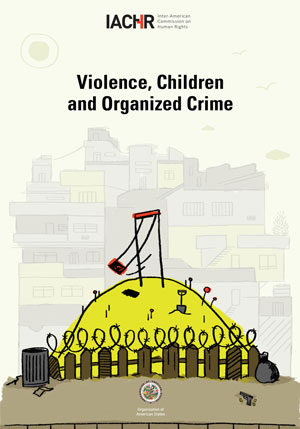There is a Connection Between Contexts of Inequality and Social Exclusion and Contexts of Violence
Inequality, low social mobility, employment uncertainty, and the intergenerational transmission of poverty continue to be major problems in the Americas.
Macroeconomic figures show positive overall outcomes, but the distribution of wealth, access to basic quality services, and the enjoyment of rights point to profound differences and inequities among groups and segments of the population.
Factors Conducive to Contexts of Violence
The increase in violence, insecurity and crime undermines confidence in the workings of democratic institutions and their capacity to stand up to and address this phenomenon, and it has led to social demands for hardline policies.
The increase in violence is due to a number of factors:
Organized Groups
Firearms
Inequalities and Social Exclusion
Lack of Real Opportunities
Social Legitimization
Institutional Weakness
Impunity
No Social Reintegration
State Institutions
Photo credit: Daniel Cima for IACHR
Homicides and Violent Deaths
Some countries are hit more intensely by the scourge of violence, particularly in countries along drug trafficking routes and in many large cities throughout the Americas due to the presence of armed organized crime groups.
36% of the violent deaths
12% of the world's population
More than one third of the violent deaths in the world occur in the Americas, which accounts for only 12 percent of the world's population. The annual rate of violent homicides in the Americas is greater than 30 violent deaths per 100,000 inhabitants. According to the WHO, homicide rates of over 10 per 100,000 qualify as epidemics.
329 homicides each day
The countries of Latin America and the Caribbean have together lost more than 1.2 million people to homicides in a single decade: an average of more than 100,000 victims per year. Organización de los Estados Americanos y el Programa de Naciones Unidas para el Desarrollo (OEA-PNUD, 2011), Nuestra Democracia, Fondo de Cultura Económica, México, pág. 182.
68 adolescents and young people are killed every day
Homicides have become the leading cause of death among the male adolescent population in several countries in Latin America and the Caribbean.
Photo credit: Daniel Cima for IACHR
47 out of 50 of the Deadliest Cities in the World are Located in the Americas
19 are in Brazil, 10 in Mexico, 5 in Colombia, 4 in Venezuela, 4 in the United States, 3 in South Africa, 2 in Honduras, 1 in El Salvador, 1 in Guatemala, and 1 in Jamaica.
There is a pattern of a higher concentration of violent crimes and homicides in big cities.
What these cities have in common is that they have grown rapidly and chaotically; they have areas or districts with only precarious infrastructure; and they lack or have very limited access to basic services.
Poor and Marginal Neighborhoods
Marginal, poor neighborhoods with limited access to basic services and little government presence are most heavily impacted by insecurity and violence.
The following factors set the stage for the emergence and expansion of criminal organizations:
Low levels of development
Lack of opportunities
Dearth of institutional presence
The activities of these armed criminal groups further jeopardize the situations in which residents of these neighborhoods live, and expose them to constant violations of their rights by these groups but also by State security forces.
Photo credit: El Confidencial

